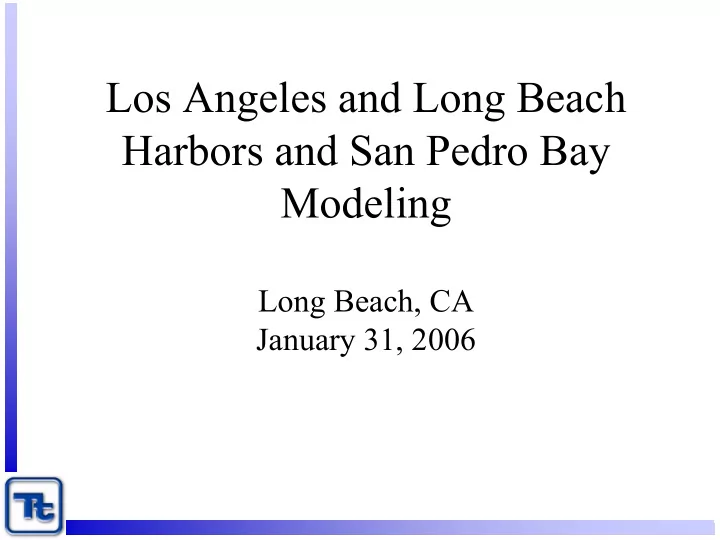

Los Angeles and Long Beach Harbors and San Pedro Bay Modeling Long Beach, CA January 31, 2006
Presentation Outline • Background • Overview of Modeling • Model Development • Model and Data Coverage • Some Preliminary Hydrodynamic Results • Schedule for Remaining Task • Discussion
Background • Modeling Tools Are Being Developed to Support TMDL Implementation in Los Angeles Harbor, Dominguez Channel, LA River, and San Gabriel River • Multiple Model Applications to Different Regions by Different Groups • Model Applications Integrated by Use of Same Modeling Software System and Coordinated Data Sharing
303D Listings
Integration of Multiple Modeling Studies • Dominguez Channel and Estuary – Everest • Los Angeles Harbor – Tetra Tech • San Gabriel River Estuary – SCCWRP • Everest and Tetra Tech Models Cover All of LA and LB Harbors and Near Shore Region of San Pedro Bay
Integration of Multiple Modeling Studies • Tetra Tech Model Will Receive Loadings from Everest Dominguez Channel Model • Tetra Tech Model Can Provide Boundary Conditions for SCCWRP San Gabriel Estuary Model and Receive Loadings • Since Models Are Based On Same Software System, They Can Be Collapsed Into Single Application if Required.
Modeling Process • Model Selection – EFDC for All Receiving Water Applications • Data Assembly and Evaluation • Collection of Additional Field Data as Required • Model Configuration or Setup • Model Calibration • Model Review • Scenario Simulations to Support TMDL Implementation
Modeling System Components • Watershed Model – Provides Non-Point Source Load to Water Body • Hydrodynamics- Provides Physics to Describe the Movement of Contaminants • Eutrophication Model – Describes the Carbon, Nitrogen and Phosphorous Cycles and the Impact of Nutrients • Sediment Transport Model – Movement of Particulate Material Including Deposition and Resuspension • Contaminant Transport and Fate Model – Describes Transport and Fate of Metals and Organic Compounds Having Tendency to Adsorb to Sediments
San Pedro Bay Watersheds
EFDC Modeling System • Public Domain, Open Source Code • Maintained by Tetra Tech with Support from US EPA • More than 100 Applications Worldwide • 3-D Hydrodynamics with Coupled Salinity and Temperature Transport • Directly Coupled Water Quality-Eutrophication Component • Sediment-Contaminant Transport and Fate Components • Extensive Pre and Post Processing
Salinity Salinity Hydrodynamics Temperature Hydrodynamics Temperature Dye Dye Organic Organic Toxics Toxics Inorganic Inorganic EFDC EFDC Cohesive Cohesive Sediment Sediment Noncohesive Noncohesive Eutrophication 22 State Variables Eutrophication 22 State Variables
EFDC Harbor Applications • Hampton Roads, Virginia – Channel Deepening, Shoreline Modification • Cape Fear, Wilmington, NC –NPDES • Charleston Harbor – TMDL • Savannah River – TMDL, Channel Deepening • St. Johns River – TMDL and NOAA Ports System • Mobile Bay – TMDL • San Diego Bay - TMDL • Portland, OR – Contaminated Sediment Superfund • Elliott Bay, Seattle – Contaminated Sediment
Development of the LA and LB Harbors and San Pedro Bay Model • Model Spatial Coverage and Grid • Data Coverage • Calibration Approach • Preliminary Results
Model Grid System • Multi-Domain with Focused Resolution • Allows Sub-Sets of Grid to Run Separately • Base Configuration Has 2140 Horizontal Cells • Fine Version with 8640 Horizontal Cells to Study Localized Problems
Model Grid System
Model Grid System
Preliminary Bathymetry 30 depth 50 45 40 35 25 30 25 20 15 Y 10 5 20 15 20 25 30 35 40 45 X
Hydrodynamic Data Coverage and Hydrodynamic Calibration • Limited Direct Physical Data – Tide Gauges – Current Meters • Salinity Monitoring Data • Calibration to Tide Gauge and Salinity Observations After High Flow EventsPreliminary Results
NOAA Ports System Data Stations
Salinity Monitoring Stations, LA Harbor
River Flows During a Salinity Transport Calibration Period
Salinity: Dec 04-Jan 05
Model Grid System
Sediment and Contaminant Transport Modeling Approach • Major Problem Is Initialization of Bed Conditions • Sediment Physical Properties – Sediment Size and Type – Void Ratio or Water Content – Surface or Profile Data • Resuspension Potential – Site Specific or Literature Values • Prop Wash and Wake Effects
Sediment and Contaminant Transport Modeling Approach • Contaminant Properties in Bed – Initial Contaminant Levels – Particulate Dissolved Organic Carbon Levels Desirable with respect to Hydrophobic Organics – Site Specific or Literature Values for Partition Coefficients
Sediment and Contaminant Transport Modeling Approach • Initialize Water Column Concentrations from Monitoring Data • Contaminant Loading Estimates • Calibration to Water Column and Bed Monitoring Data
Status and Schedule • Hydrodynamic Model Currently Nearing Calibration – Complete by 31 March ‘06 • Sediment and Contaminant Transport and Fate Model – Preliminary Model Setup in Progress – Calibration Completed During Fall ‘06 • Calibration to Water Column and Bed Monitoring Data
Questions and Discussion
Recommend
More recommend